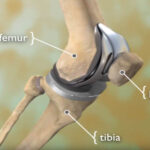Knee replacement surgery has long been an essential treatment for individuals with degenerative knee pain and limited mobility. The use of robotic knee replacement is a game-changer compared to traditional techniques. This new technology make surgeries better with perks like improved accuracy, faster healing, and overall recovery for your knee joint.
In this guide by Dr Simon Thomas, a robotic knee surgeon in Delhi you will understand the difference between robotic and traditional knee replacement surgeries.
What is traditional knee replacement?
A skilled knee replacement surgeon replaces a broken or diseased knee joint with an artificial implant. They do this using manual techniques and instruments. It is an orthopaedic surgery procedure that replaces a damaged knee with an artificial joint. It is often performed when non-surgical treatments are not effective.
What is robotic knee replacement?
A robotic knee replacement is a surgery is where doctors use a robot-assisted system to perform knee replacement surgery. When it comes to the surgery, they do some tests like CT scans to make a 3D model of the patient’s knee. These models help the doctors plan ahead of time and assist them during the actual procedure.
Difference between robotic knee replacement and traditional knee replacement
Here is the comparison between robotic and traditional knee replacement:
| Robotic knee replacement | Traditional knee replacement | |
| Surgical control | Surgeon-controlled with robotic assistance | Surgeon-controlled and entirely manual |
| Technology | Manual surgical techniques and instruments | Robotic technology |
| Precision | It depends on the surgeon’s skills | It has enhanced precision through real-time feedback and planning |
| Imaging | Standard X-ray and MRI | Detailed 3D imaging – CT scans |
| Implant alignment | It depends on the surgeon’s visual and manual judgement | Improved alignment accuracy with robotic guidance |
| Recovery time | Standard recovery process | It has potentially faster recovery due to more precise surgery |
| Cost | Generally less expensive | Typically higher costs due to advanced technology |
Benefits of traditional knee replacement
- Proven Track Record: Traditional knee replacement has been performed for decades and has a well-documented history of success, providing relief and improved mobility to millions of patients.
- Surgeon Experience: Many surgeons have extensive experience and expertise with traditional knee replacement techniques, contributing to high success rates.
- Widespread Availability: Traditional knee replacement is widely available at most hospitals and orthopaedic centres, making it accessible to a wider number of patients.
- Cost–Effective: Typically less expensive than robotic-assisted surgery due to the absence of costly robotic systems and related technology.
Benefits of robotic knee replacement
- Improved accuracy: Robotic technologies improve surgical precision, which leads to more consistent results and fewer revision operations.
- Minimal invasion: Robot-assisted knee replacement surgery uses minimal incisions, allowing for faster recovery time.
- Personalised Implant Placement: 3D modelling and real-time modifications allow for personalised implant placement, leading to improved joint performance and durability.
- Robotic devices can reduce injury to surrounding muscles and ligaments, allowing for a speedier and less painful recovery.
- Patients may have a shorter hospital stay, faster recovery, and less discomfort due to less tissue stress, fewer incisions, and optimal implant placement.
Traditional vs Robotic knee replacement in Delhi: Which is better?
The choice depends on the patient. Robotic knee replacement is precise and offers quick recovery, and traditional knee replacement is widely available and more cost-effective. Consulting with an experienced orthopaedic surgeon can help determine the best approach based on the patient’s specific needs and circumstances.
Precision and accuracy
Robotic knee replacement offers precision and accuracy in implant whereas, in traditional knee replacement, the precision and accuracy depend on the surgeon’s experience and skills.
Recovery time
Robotic knee replacement may lead to faster recovery and reduced pain, whereas with traditional knee replacement, the recovery can be comparatively slow and may vary according to the patient’s factors.
Cost
Robotic knee replacement is generally higher in cost due to its advanced technology and precise technique, whereas traditional knee replacement is more cost-effective and available across many hospitals and orthopaedic centres.
Expertise
In robotic knee replacement, surgeons require training before operating to achieve perfection, whereas in traditional knee replacement, many surgeons have extensive experience with traditional methods.
Complexity
Robotic knee replacement is ideal for patients seeking the latest technology, whereas traditional knee replacement is versatile and suitable for various patients even those with complex knee anatomy.
There are many differences between robotic and traditional knee replacement surgeries, even though they provide considerable advantages for patients having problems with their knees. Consequently, both traditional and robotics-enabled surgery should be considered based on the patient’s requirements, the kind of knee damage, the technology in place and the skill of the surgeon involved. Consulting with an experienced orthopaedic knee surgeon in Delhi like Dr Simon Thomas – the number one surgeon in Delhi can provide personalised guidance to help determine the most appropriate approach, ensuring the best possible outcomes for the patient’s health and mobility.













